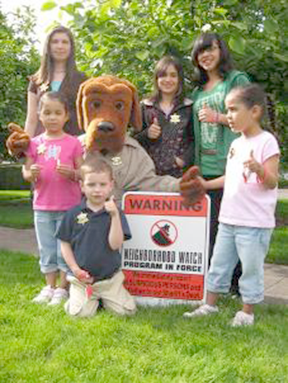Public Safety News October 2021

Neighborhood Watch leaders meet
The Washington County Sheriff’s Office continues to build connections and empower community members to create friendly and safe neighborhoods. How? Through deliberate efforts to expand the Neighborhood Watch Program—though it’s not your parent’s neighborhood watch from the 70’s!

“Neighborhood Watch has grown in both safety for community members and effectiveness,” says WCSO Community Education Specialist Brenda Schaffer. “We found that it is more effective and vastly safer to encourage participants to get to know their neighbors, be observant and take good notes, and call in an emergency or a non-emergency report promptly. We don’t advocate neighbors walking their streets at late hours to walk up on a crime in the act. That’s not at all safe.”
Neighborhood Watch launch meetings have all been virtual since the start of the Pandemic. In these meetings, Schaffer and her education outreach colleagues discuss neighborhood specific concerns; they listen, and they encourage simple steps like meeting your neighbors to make neighborhoods more friendly and safe. “If you know who your neighbor is, it’s much easier to know if that fellow walking around at 11:45 pm is from four doors down, who works swing shift and takes a walk after work; or if the person trying to get the neighbor’s car door open isn’t the neighbor. We also build confidence in communities so when they see something suspicious or see an overt crime, they call the best number—911 or non-emergency—immediately.”
When the crime rate is high, and a Neighborhood Watch is new, everyone is on their toes, but as time continues, it’s harder to keep up the momentum. “The rest of life happens, and since the neighborhood has been problem-free for a while, it drops on the personal list of importance. It is understandable, but it allows problems to start creeping back into the neighborhood again,” explains Schaffer.
To keep up the sense of importance for neighborhood safety when times are easy, Schaffer discussed the dilemma with several local Neighborhood Watch coordinators. “Everyone had two comments in common: They wished they knew their fellow Watch and safety leaders in other neighborhoods, and they wished for ongoing useful information to share with their neighbors as reminders to pay attention to safety.”
Schaffer saw the opportunity to help and launched the Quarterly Safety Leaders Roundtable, a virtual meeting welcoming Neighborhood Watch and community safety leaders. This meeting allows opportunies to get acquainted, share ideas, review current crime concerns, and receive useful information, flyers, and meeting announcements to share with their communities. WCSO hosted the first of these Roundtables last July.
“Tualatin Valley Fire and Rescue (TVFR) shared their valuable Ready, Set, Go wildfire safety information and links to their community presentations on the topic for these leaders to pass along. Our next Roundtable will be on October 5. Bethany area School Resource Officer, Deputy Yoshimura, will drop in to answer questions and pass on safety information for neighborhood parents and children. Detective Altiere will also plan to discuss Sheriff’s Office programs available to curb specific problems that pop up in neighborhoods. In each of these meetings, we encourage open discussion of local concerns and offer an array of resources to leaders to share.”
If you are a Neighborhood Watch coordinator filling this role in an unregistered Neighborhood Watch program, a property manager, safety coordinator for an HOA or an HOA president, you are welcome to attend the next Safety Leaders’ Roundtable on October 5 at 7 pm. If you wish to receive the virtual link to attend, please email Brenda_Schaffer@co.washington.or.us with the neighborhood you represent, the number of households, and your role in sharing information with your community.
The Safety Leaders’ Roundtable is another outreach effort of the Enhanced Sheriff’s Patrol District (ESPD) providing law enforcement services for more than 237,000 residents in the urban areas outside of cities in Washington County, including Bethany, Cedar Mill, Cedar Hills, Bonny Slope, West Slope, Oak Hills, and more. Voters first approved the ESPD in 1987 and all local option levies since then.





